Honduras: Tegucigalpa, Copan Ruinas, Gracias
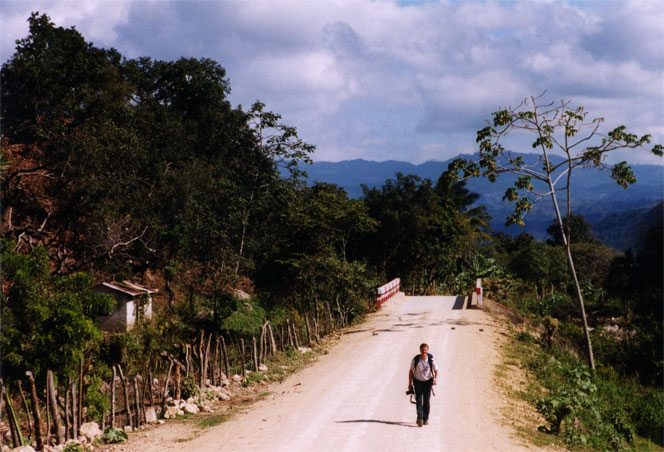
December 27, 2002
Although I found out overnight, by reading my guidebook, that Danli is the cigar capital of Honduras, I didn't think I could interest either Mike or Andrew in staying a day to check out the town a little more. We walked back to the bus stop and bought tickets on a luxury bus to Tegucigalpa. No one bothered us any more than they did the other people waiting for the bus. Even when hawkers would arrive, they wouldn't work very hard to sell us anything. One "No," and that was it. When the bus rolled up, we followed the local (Central American) custom of elbowing our way onto the bus. The only people who waited patiently were tourists who hadn't been on the ground for very long: You definitely want a seat on the bus.
The bus rolled through the mountains for an hour before dropping down into the valley holding the Honduran capital. It looked just like an American city, only more polluted and with more trash on the streets. Cars generally don't have particularly functional exhaust system (no catalytic converter) and my nose started to itch from all the fumes. The bus stop was out the outskirts of town and Tegucigalpa is on the outskirts of town, which forced us to take a taxi into the center, where we found a nice hotel called Nuevo Boston. $30 got us a room with three beds and hot water, plus a lot of charm and no television. We dropped our stuff and went out for a stroll through the streets to see what the town was all about. The National Cathedral was close by (we could see it from our balcony) and we headed that way.
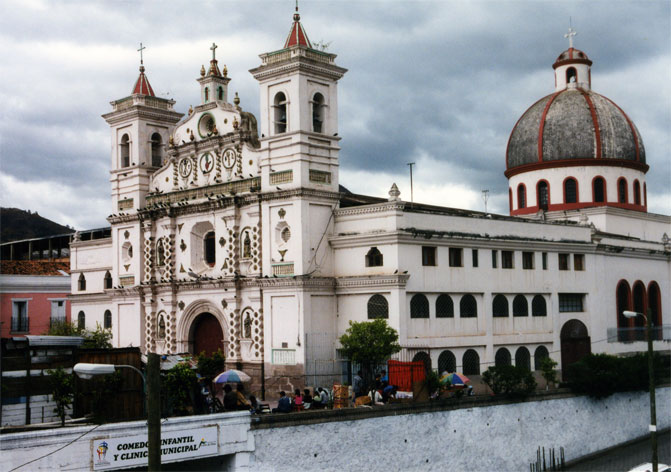
The cathedral was located at the head of a large plaza, just like in Leon. However, this one was jammed with people and had lots of stores with neon signs ringing it. Armed soldiers stood around on the street corners, perhaps indicating that things here are not always so sedate.
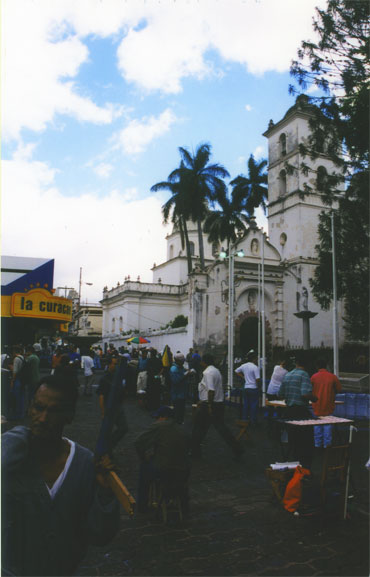
Feeling a bit hungry after our long, hard morning, we walked around the plaza and ducked down a sidestreet that held a small cafeteria. A few lempira bought us the set-plate meal: Grilled pork, rice, beans, fresh tortillas, salad. While not up to the standard of Nicaraguan street food, it hit the spot and gave us the energy to face the rest of our hard day. After failing to find a used bookstore listed in the guidebook (and finding a different one) and finding the National Art Gallery closed for remodeling, we went back to the hotel for a siesta. This seemed a little too lazy to me, so after a few minutes of siesta, I walked down to the corner bakery and bought a piece of excellent glazed yellow-cake. While the Nicaraguans had the lead in street food, the bakery was simply incredible. A half an hour later, I went back and bought two more pastries to fuel my loafing.
Around 4 pm we finally got up from our hard after noon and decided to get a view of the city before eating dinner. A fifteen minute walk up hill past swanky looking homes got us to Parque La Leona, which seemed to be a popular spot with furtive lovers and kids with too much time on their hands. It did have a nice view of the city, complete with the pollution ring-haze hanging above the city.

After running off a small gang of kids, we considered our work for the day done and went in search of dinner. Chinese food is just about everywhere in the world, and we found it in Tegucigalpa as well, only a few minute walk from our hotel. After a few beers to warm us up, they brought out our food. I had ordered wonton soup and chicken noodles. The bowl of soup was approximately a gallon's worth. The bowl of noodles easily weighed five pounds. Mike and Andrew had ordered similarly, and we all looked at each other with a mixture of amusement and fear. I did as best as I could, and even managed to finish half of the noodles and most of the soup. Our bill came out to be $3 a piece, including beer. I had difficulty walked down the street, particularly as it was pitch black out and there were no street lights and fell in a few pot holes located on the sidewalk, much to the amusement of a passing Honduran. We tried to walk off our meal with a stroll in the plaza, but this seemed like too much work so we instead retreated to the hotel. We did have a tough day planned for tomorrow: Luxury bus to La Entrada, school bus up to Copan. I imagine we might have a few beers and dinner as well. Hard life in Honduras.
Andrew bartered with a taxi driver in the early morning to try to get the price down to something a bit more respectable, but when he started to drive off we relented and paid the extortion to get to the bus station. There were several gringos standing around waiting for other buses, but they seemed to be in their own little world. When their bus pulled up, the waited patiently for everyone else to get one (all the others were elbowing like mad) and then they hopped on last. The bus rolled out of town and I could see them standing in the aisles along with the other thirty people who had not managed to get seats. The three of us shook our heads at each other in dismay, and prepared ourselves for the battle to get a seat. We had a long bus ride, and standing for it would be a real blow to our theme of general laziness. When our bus arrived, the polite elbowing began as the mob crushed for the door of the bus. Our large size helped and all three of us managed to get on the bus after only ten or twenty Hondurans had. Not bad, I thought.
The bus rolled out of the congested capital and back in to the hills. Honduras is a lot greener than Nicaragua, perhaps because of the more mountainous terrain. Lots of small farms and an occasional town gave the countryside a certain quaintness that was hard to resist: I wanted to hop off and go for a looksee. For all I knew, however, I might be hopping off in a particularly unsavory town. I didn't want to give up my seat anyways. After blowing through San Pedro Sula, the AIDS capital of Central America, we climbed back up into the hills and into the pleasantness once again. A few more hours brought us to the crossroads town of La Entrada, where we got off the bus and waited for a school bus to take us the 60 kilometers to Copan Ruinas, home of some world famous Mayan ruins.
Waiting as well was a Swiss man named Matt, traveling independently, though very heavily. He had been traveling in Central America for five weeks now and was generally heading south. There were only the four of us plus another four locals on the old school bus that crawled slowly up and over several mountain ridges on the way to Copan. It didn't seem to be a very popular destination, which boded well for tomorrow when we would head out to the ruins. The town of Copan was really quite nice, but my beliefs about the lack of tourism in Copan were quickly dashed. Immediately upon stepping off the bus, a tout engaged us and followed us from one hotel to the next telling us each was full, or closed, and that he would take us to his hotel where he could give us a great price (not telling us how much, of course). This only happens in places tourists frequent and it was the first time it had happened in Central America. One of the hotels really was closed. We followed him to another one, whose owners didn't seem to recognize him and chased him away. The Hotel Rosalila ran us $25 for a triple, with Matt in an adjoining room. We even had satellite TV so that Mike and Andrew could watch soccer highlights.
Having had such a hard day of traveling on buses, we just had to get something to eat and unfortunately chose one of the Lonely Planet's backpacker's haunts. Over priced, not very good TexMex food. Loud music. Dull gringos. To make up for it, the four of us walked over to a liquor store and bought some wine and a liter of Floer de Cana 12 year old rum. The rum ran us about $6 and would easily have been $25 in the States. A bottle of NightTrain in the store went for the same price as the rum. The four of us retired to the triple for drinks and stories and more soccer highlights. In the end, the room span and I thought it best to go to sleep. Besides, the rum was gone and we had to get up early to beat the tourists to the ruins.
The effects of the rum combined with the early hour of our rising made me a little salty as we walked the kilometer or two to the ruins. After paying various entry fees we strolled down a shady lane to a guard station, complete with colorful birds. Their wings had been clipped to keep them from flying away.
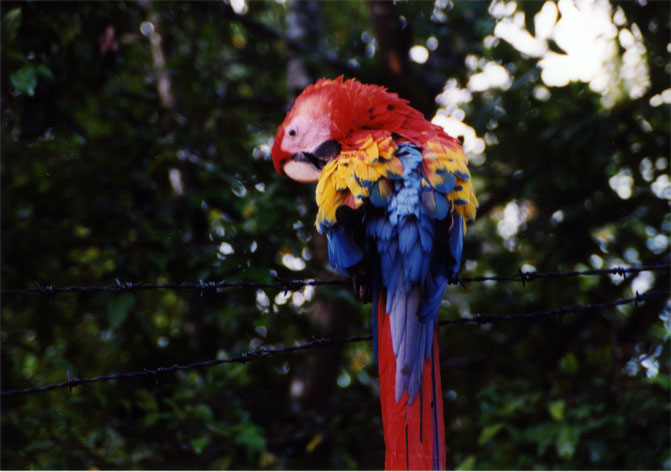
The ruins were spread out over a large area, with the first area being a large, immaculately trimmed grass court filled with various statues and carvings, each with a small sign in English and Spanish telling us what various parts of them were and what they stood for.It was like being in an art museum, except the sun was shining and there wasn't soft music playing on a stereo.
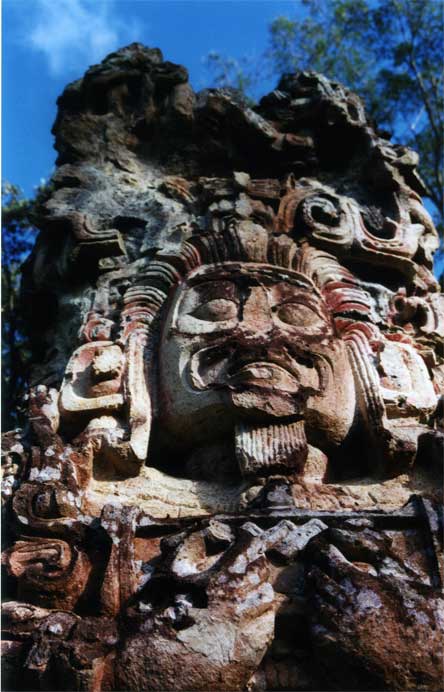
Some of the stellae had some residual paint on them, but it wasn't clear how much was original and how much was added in the past. While Tikal, in Guatemala, is known for its soaring buildings, Copan is known for its sculpture and carving, which is, apparently, somewhat rare in the Mayan world.

After walking about the stellae area for an hour or so we preceded through the complex toward some small ballcourts and temple buildings. Tourists had begun to filter into the ruins, complete with tour guides, although few seemed to be be as white as we.

Very little was off limits at Copan and the authorities seemed to encourage visitors to scamper around the buildings and examine things as they saw fit. I liked this scheme immensely and my feelings of an art museum vanished as I lost myself in the feeling of the place.
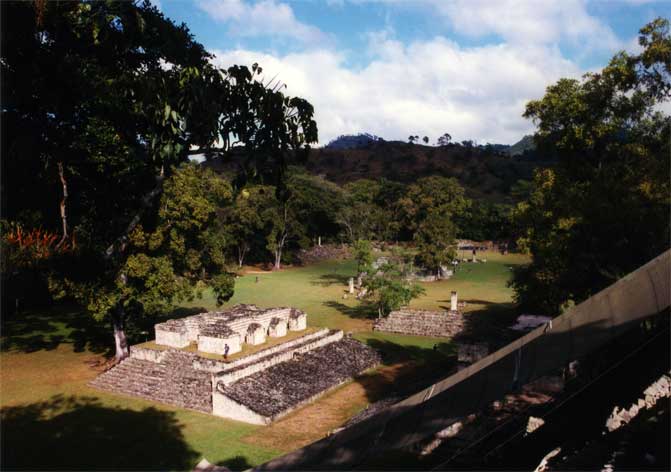
Since temples are frequently built on old temples, the archaeologists had opened a tunnel down under one of the existing ones so that visitors could see what the old ones looked like. They wanted a few more lempira for this and I declined to pay, preferring the fresh, open air to the underworld.
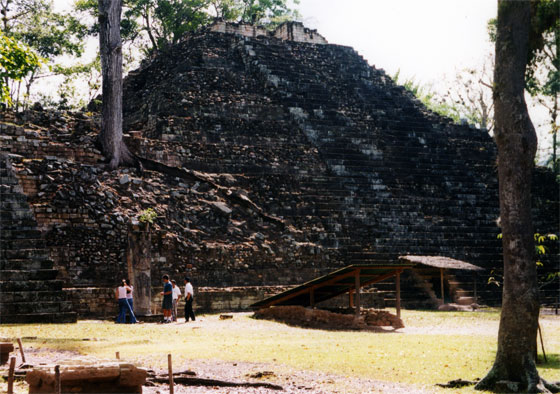
Andrew went down under the temple and Mike went off to photograph something or other and I was left to my own devices for a while. Rather than walk about, I instead found a pleasant place in one of the ball courts to have a sit and to try to imagine what life was like in Copan. Probably a lot like life today, I thought, but more colorful, at least to my modern eyes. The exotic always seems colorful.

Tired of my sitting, I climbed up to one of the highest temples to have a look at the countryside around Copan. Various signs had indicated that the complex spread out for quite some ways in all directions and I was hoping to get a glimpse of the edges of development. All I got for my efforts was a good view.

I walked around the top of one of the buildings before spotting Mike and Andrew down below in a ball court next to a really neat sculpture of the head of some beast. Maybe a cat. Or a lizard. But cool nonetheless.

A little hungry, and tiring of the increasing number of tourists, we went to the cafeteria and had some lunch before poking around the museum. While it contained interesting displays and some of the more precious sculptures, I was beginning to fade and spent most of my time moping, rather than looking and thinking. After an hour of my sour mood, we walked over to another outdoor facility called Las Sepultras (some sort of burial place, I suppose) only a kilometer or two down the road, where there was yet more art work, including some very nice relief work.
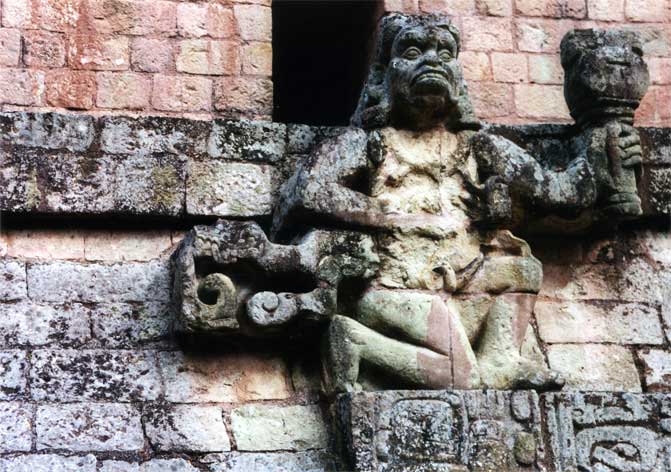
I had lost interest in the Maya, mostly due to general lethargy and my inclination to laziness, and wanted to sit around, instead of walk around and look at more relics of the past. However, the relief work really was intriguing and when we had returned to the hotel, I was glad we had spent most of the day in the ruins. After the customary three beer dinner, I declined to buy more rum remembering the ill feeling of the recent morning and instead turned in early.
With no particular goals in mind, we slept until the late hour of 7:30. I felt refreshed from the previous day and positively salubrious when we settled into breakfast at a local place that had actual, real coffee. Surprisingly enough, given the amount of coffee exported from Central America, most of what you get in cafes and restaurants is of the instant or cheap variety. Over beans, tortillas, eggs, fried plantains, sausages, and queso fresco, we mulled over a plan for the day, which involved much less work than yesterday. Chief among them was to change some more money and to call our respective airlines to confirm that we really did want to travel on the return tickets we had purchased. TACA told me to show up to the San Salvador airport four hours early, to make sure of getting a seat on the flight back to Miami. Slightly at a loss for what to do after leaving the telephone office (yes, an actual office, with operators, was necessary to place a phone call), we decided to stroll along the Rio Copan and up into the hills, where some sort of resort was supposed to be located.
Almost immediately upon leaving the center of town, the land was transformed from tourist-oriented, to one of agriculture; very peaceful, despite the ominous skies overhead. We strolled up to the top of a hill, following a dirt road, where there was a nice view over the valley of the Copan, and sat around for a while, debating whether or not to try the resort. In the end, laziness overcame us and we walked back down the hill and into town for an afternoon snack at the breakfast place. Besides the excellent coffee, the place served up some wonderful banana liquados (milkshakes, it seems) and baleadas, which apparently is something of a coast thing (we were nowhere near the coast): Black beans, queso fresco, fried eggs, and sour cream wrapped up in a warm tortilla. Great stuff.
After a stroll around the tourist shops (I bought a shirt and some coffee), we retired to the hotel for a siesta, despite the weather being quite tolerable even in the midafternoon. I napped and wrote out a few postcards which Mike went into town and mailed, and then took another nap. It was finally time for the evening meal, which was back at the breakfast place and consisted of more baleadas and other snack-like stuff, accompanied by the requisite three beers. Walking back to the hotel, it occured to me that despite the walk up to the hill in the late morning, today had been one of the absolute laziest of the entire trip. I loved it.
As we had a long day of traveling to do today (riding on chicken buses is taxing), we had a sit down breakfast at the place with the good coffee. I even got a respectable ham and cheese omelet, washed down with several cups of the house's finest grind. The chicken buses were mostly empty, which made the trip much easier. We retreated to La Entrada (2.5 hours), then took another bus to Santa Rosa de Copan, and then finally another bus up into the hills to Gracias which was the capital of all of Spanish Central America for a few years in the 16th century. Apparently a thin vein of gold had been discovered nearby, but was quickly played-out and interest in Gracias waned. However, being located in the mountains it has a much healthier climate than down in the lowlands and it was never abandoned entirely. Four and a half hours of traveling and we arrived, starving in the charming town. Mike and Andrew didn't seem to mind too much, but I was dying for something solid to eat.
We found our way over to the Hotel Guancascos, which was almost empty despite being a really rather amazing place. Situated on a hillside with nicely kept gardens (complete with decorative coffee trees) and run by a Friesan woman, the hotel was amazingly cheap ($18 for a triple) for the grounds. We ate some lunch on the balcony before the owner whisked Mike and Andrew off to some local hot springs for a soak. I took a nap instead, and then a shower. By this time the boys were back and we sat around on the porch in the sun and read for a while. Wonderful use of time, I thought.

It being New Years Eve, all of the employees of the place had the night off so we had to go outside for dinner, braving the multitudes of firecrackers that seemed to be the chief source of amusement for the towns residents, both young and old. After a standard dinner of pollo asado and three beers, we walked over to a store and bought some rum and wine, not escaping the notice of shadowy figures hidden in alleyways armed with firecrackers and laughs, though we were able to make it back to the hotel with our pride mostly intact. I would have given several dollars for a few dozen bottle rockets with which to defend ourselves. I tried hard to stay up until midnight to celebrate the new year, but managed only 11 pm before falling into a rum-induced sleep.
It being New Years Day, almost nothing was open for breakfast in the morning. After stumbling about, we did find that the cafe in the Hotel Colonia was open and had a pleasant breakfast of coffee, tortillas, queso fresco, some sort of pickled salad, beans, eggs, and sausages. Mulling over our guidebooks, it seemed that the best thing to do was to walk to a village called La Campa, a mere 16 kilometers away. While the weather was fine, I realized rather early on that neither Mike nor Andrew thought much about hiking 32 kilometers round trip under the sun. As we were strolling leisurely, the walk in the countryside would have taken us all day and part of the night to complete. Fortunately, none of us were really keen to get to the village and mostly just wanted to see some of the Honduran countryside. A more Edenic place is hard to imagine. Small farms, lush and green, with mountains in the distance and valleys far below us. Hills, fields, and funky trees provided something to chatter about.

We'd walk for thirty minutes or so, and then find some shade under which to sit and rest for a while, although it was unclear what we were resting from. Perhaps it would be more accurate to say that we sat about and lazed in the shade. Occasionally a truck would pass us and offer us a ride, but we were perfectly happy seeing the countryside at our own pace.
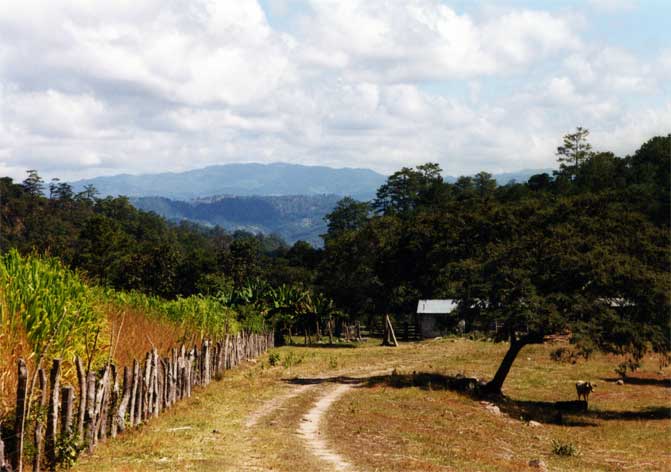
I was happy simply to be out walking and not cooped up on a bus traveling somewhere. I had been in a bit of a funk since leaving Nicaragua and think due to too much time spent on the yellow school buses that form the primary mode of transit in Central America. I was glad that we were staying in Gracias for a while, particularly since there was no big attraction in Gracias other than the town itself and the land around it. Tomorrow we were going to a national park called Celaque (waterbox), which holds the highest peak in Honduras, to poke around a bit and walk part of the walk up it.

I much prefered this time spent in the countryside to the rushing about of the first few days in Honduras. While Leon had been attractive for social reasons, I felt more comfortable out in the countryside and Gracias was competing rather well with Altagracia for my favorite place on the trip. While sitting in some shade, located nowhere in particular, we decided to turn around and walk back to Gracias. We had made it perhaps halfway to La Campa and none of us seemed disappointed not to have made it to town.
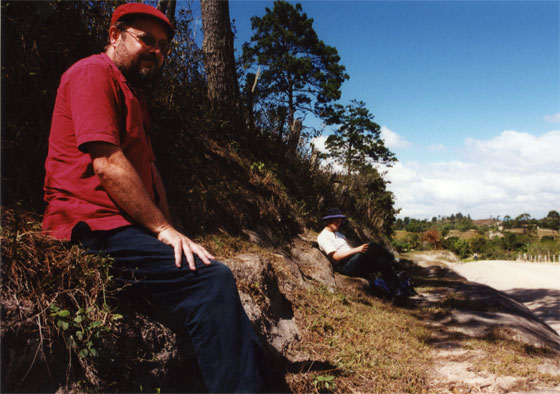
We returned to the hotel, where I took a nap and then read a few pages out of Lord Jim while Mike and Andrew looked around town, apparently feeling more energetic than I after our stroll in the countryside. Upon their return, we went out for dinner, drank the usual three beers apiece, and then retired to the hotel to choke down the rest of the wine (it had turned to vinegar quite a long time ago) from the night before and watch soccer highlights on the satellite TV.
After their two day break, the hotel staff had returned, which meant that we were able to get breakfast in the hotel rather than having to go out in search of it in town. Wonderful coffee, ham, eggs with salsa, tortillas, cream, and queso fresco got the day off right. Almost immediately after breakfast we found out that a truck was going out to Celaque in five minutes and we might be able to catch a lift in it if we hurried. We quickly tossed a few things in our pack and then headed down to the driveway, where the truck was just getting ready to leave. As things turned out, we had to wait for an hour before it left. We were ready, the driver was ready, but just as wheels were about to roll, an American family from Colorado showed up at the hotel and delayed things for rather a long time. When they finally managed to get into the bed of the pickup with us, the driver drove especially fast along the rocky road to the park to make up for lost time. The drive only took twenty minutes and was especially hard on my backside. If we had set out walking when we were ready, we probably would have arrived at the park at about the same time the truck actually did. And, we would have arrived more comfortably as well. I was ready to vow that I would walk back, rather than hitch, but could tell from Mike and Andrew's faces that they were thinking the same thing and that there was no reason for me to state the obvious.
After paying a nominal entrance fee and looking around at some of the front country attractions, we headed up the trail toward the top of the mountain, which was too far away for us to reach today without a lot of exertion. The American family apparently planned to hike all the way to the top and then come down and camp somewhere. I felt rather sorry for the kids, as this was too much for them, but it all worked out well in the end. The father was in rather poor shape and was trying to carry all the gear for the entire family on his back, and consequently didn't make it very far up the hill. It didn't help that he had forgotten to pick up a map of the route up to the top and Mike had to give him ours to convince him that there was no way he would make the top of Celaque before tomorrow. Andrew decided to hang out near a river while Mike and I walked up hill a little while longer, just to see if some views might be had.

We eventually tired of walking up hill in the forest and came back down, passing the sweating, exhausted father who had separated from his family in order to make better time to the summit. Without a pack and in good shape, he probably could have made the top in five or six hours. But, he had one and not the other. We said hello to his much more sensible family, who were sitting alongside the river where Andrew had decided to rest. We found him near the visitors center and then began the stroll back to Gracias along the rocky road.
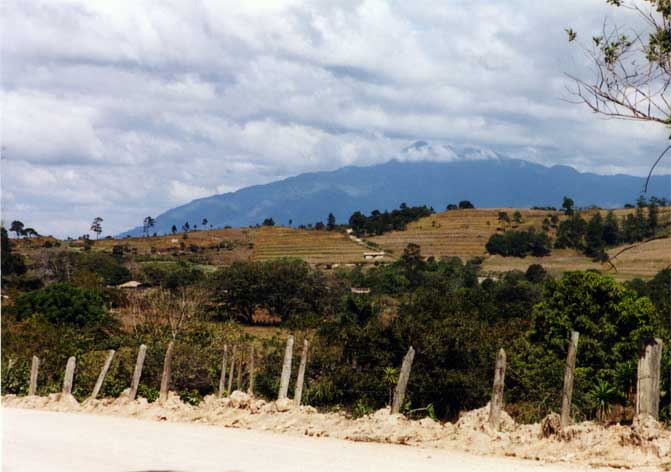
Clouds began to roll in, but we did get a few reasonable views toward Celaque, although it was unclear if we were starring at the highest point in Honduras, or merely one of its outlying peaks. The leisurely walk back to town was much more comfortable than the bumpy, arse-jolting ride that we had taken to the park, and we even found a bit of shade here and there to rest in. It wasn't a long walk back to town, but we took three or four breaks nonetheless.
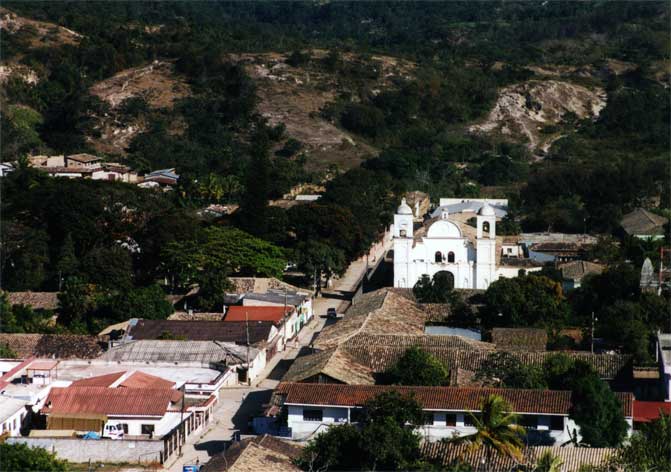
Back in town I decided against a siesta and joined Mike and Andrew in the fort that sat on top of the hill, on the side of which was located the hotel. This provided excellent views of the town and the countryside, along with the picturesque church located at the center of town in the plaza. Such a wonderful day. Really, two highly pleasant days in the highlands of Honduras, with no regimented plans, no buses, nothing other than strolling about and seeing what the area was all about. This was exactly how I imagined traveling should be, and I was rather sad that tomorrow we would be leaving this place and getting back onto chicken buses. As the sun started to sink toward the mountains, thoughts grew toward food and the evening beers. The last of the warm sun fell on my face and reminded me of the cold and snowy midwest that was waiting for me in a little over a week, adding to my melancholy.
























